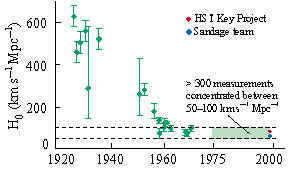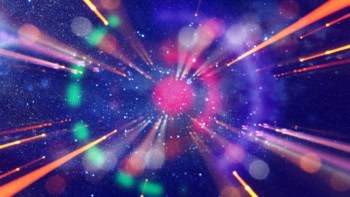
Freedman’s result comes at a time when there is growing optimism in cosmological circles that the set of long sought-after numbers that define the form and age of the universe will soon be nailed down (N Bahcall et al. 1999 Science 284 1503). The implications for mainstream astronomy would be profound.
The significance of the Hubble constant lies not only in setting the physical scale of the universe, but also in constraining its age. But getting answers from the Hubble-constant measurements that are consistent with direct chronological measurements of stars and atomic nuclei has been notoriously difficult in the past.
The Hubble constant is normally measured by comparing the physical distances of galaxies with the velocity at which they are receding. Edwin Hubble’s original measurement suggested that the universe was expanding at 550 km s-1 for each megaparsec (3.26 million light-years) of distance travelled. Together with his estimate of the curvature of space based on the number of faint galaxies he could count, his measurements implied that the universe was younger than the Earth’s rocks. This caused Hubble to doubt his interpretation that the universe was expanding. A later version of this age conflict contributed to Fred Hoyle and others proposing the steady-state model, an alternative to the big-bang theory in which the universe is uniform in space and time.
The velocity with which the galaxies are receding can be determined with high precision from the light that they emit, which is “redshifted” to longer wavelengths on its journey to Earth. The challenge lies in measuring the absolute distances to the galaxies. Freedman and colleagues use a technique similar to the one employed by Hubble in 1923 to measure the distance to the Andromeda spiral galaxy. The method relies on a special class of pulsating stars, called Cepheid variables, which brighten and dim with a period that is correlated with their luminosity. These “standard candles” provide very reliable and accurate distance measurements. Freedman and co-workers used the Hubble Space Telescope (HST) to measure the period of almost 800 Cepheid stars in 18 galaxies up to 65 million light-years away. (In contrast, Edwin Hubble detected Cepheids just over 3 million light-years away using the 100 inch telescope on Mount Wilson.)
The HST has two important advantages over ground-based instruments. Thanks to its superlative angular resolution, the Cepheid variables can be more reliably isolated from other stars in crowded regions of nearby galaxies, yielding much more accurate photometric measurements. Secondly, as it is never cloudy in space, the all-important period of the Cepheid variables can be measured with fewer, well timed observations. Once the team was confident that they were able to accurately measure the distances to the Cepheid variables in nearby spiral galaxies, they were able to calibrate a relation that connects the rotational motions and luminosities of distant spiral galaxies. In this way, the team extended the range of the observations that are visible to the HST to distances much further than the Cepheid variables.
The Key Project team secured 420 hours of observing time on the HST over 8 years and the outcome is a considerable accomplishment in every respect. A significant step forward in the Key Project study was the exhaustive treatment of systematic errors. The team used a range of methods to independently verify its final value. These included using the motion of stars in elliptical galaxies and the peak luminosity of well studied supernovae. The outcome gives many astronomers confidence that the 10% uncertainty is realistic.
The measured value of the Hubble constant has varied over the years, culminating in a figure of 70 km s-1 Mpc-1 from Freedman and co-workers, and a figure of 60 km s-1 Mpc-1 from a rival team led by Allan Sandage, also from Carnegie Observatories (see left). The upshot from these measurements is that the universe is unlikely to be less than 11 billion years old, which is just about consistent with the latest estimate for the age of the oldest galactic stars. Moreover, the cosmic age inferred by both teams is no longer in conflict with independent estimates. Charles Lineweaver of the University of New South Wales in Australia has used recent observations of the cosmic microwave background and six other cosmological measurements to constrain the age of the universe to be 13.4 ± 1.6 billion years (Science 1999 284 1503). Significantly, a precise age is now more dependent on the rate at which the universe has been decelerating since the big bang, rather than on the Hubble constant.
In his book The Cosmological Distance Ladder, the British astrophysicist Michael Rowan-Robinson discusses how, in 1976, Allan Sandage and Gustav Tammann quoted a figure of 50 km s-1 Mpc-1. This value was a factor of two lower than the figure quoted by the late Gerard de Vaucouleurs. Sandage, to his credit perhaps, has consistently argued for a lower range of 50-55 km s-1 Mpc-1 for almost 25 years. His claim is based on the distance to Cepheid variables in galaxies in which supernovae, the most precise form of standard candle, have exploded. The satisfying recent convergence of Hubble-constant measurements is largely due to a downward trend from high values. Notably, the Key Project team’s first substantial stab at the Hubble constant in 1994 gave a value of 80 km s-1 Mpc-1. However, Sandage’s value has also crept up subtly, reaching 60 km s-1 Mpc-1 for the first time. After the controversy of the past 25 years, this is real progress!
But to what extent could this convergence be a transient phenomenon? Given time, could Freedman and colleagues contemplate an even lower value, corresponding to an older universe, as argued by Sandage? And should we be impressed by Freedman’s claim of “precision cosmology” given this is hardly the first time that the constant has been quoted to 10%? Indeed, Sandage quoted a 10% error on his 1975 value and now claims a precision of 3%. As the rivals use similar techniques, progress towards an agreement at the 1% level, for instance, will inevitably be slow – we are not going to wake up one day and find worldwide acceptance of any particular value. In the long term, other techniques based on satellite measurements of fluctuations in the cosmic microwave background may be more promising.
The Hubble constant is only one of several numbers that astronomers need to define the form and history of the universe. Others include the rate at which the universe is decelerating, which can be estimated by tracking the distance-redshift relation to great distances and early times, for example using supernovae. Another is the overall curvature of space, which is best estimated from the angular scale of features seen in the cosmic microwave background.
But there is an interesting, and perhaps perverse, twist to the story. Just at the time when astronomers have made great progress in measuring the Hubble constant, and a promising start in measuring the change in the rate of expansion over time, there is now growing evidence that the universe is accelerating, not decelerating as was once thought. If this is confirmed, one more target for observational astronomers will be to measure the so-called cosmological constant – a “vacuum energy density” thought to be responsible for the acceleration.
For decades measuring any of these parameters was regarded as a hopeless observational task, one necessarily riddled with unreasonable assumptions and beyond the capabilities of the telescopes available. It is a tribute to the skill and tenacity of both the scientists who operate the HST and the various teams of astronomers who analyse the data that there is genuine optimism that the various numbers will be nailed down soon. Although it is easy to dismiss the hype associated with the recent press releases, the underlying progress is tremendous. However, as the recent evidence for the existence of the cosmological constant demonstrates, there may still be surprises in store.
In his book The End of Science, the writer John Horgan predicts that the rapid progress towards measuring the cosmological parameters would leave something of a wasteland for astronomers in the next millennium. On the contrary, much progress in astrophysical cosmology concerning the origin and growth of structure, and the history of star and galaxy formation, is currently hindered by our poor knowledge of these parameters.
Finally, should we really be surprised that the Hubble constant lies in-between the values championed by opposing teams? In 1985 Rowan-Robinson predicted that the value would settle at 67 km s-1 Mpc-1. And, of course, the recent convergence will no doubt mean that both rival teams will ultimately claim success. The only real loser in this long-standing saga appears to be Douglas Adams, who gambled in the Hitch-Hiker’s Guide to the Galaxy that the truth must be 42.




